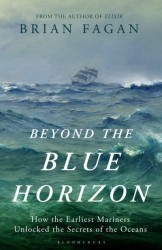
To the Sea, a Book Review
Beyond the Blue Horizon: How the Earliest Mariners Unlocked the Secrets of the Oceans
By Brian Fagan
Bloomsbury Press, 2012, 313pp.
Newfoundland and Labrador 1700: in the morning dawn, boat crews are setting off the southeastern coast for another day of cod fishing. The water is calm, the skies clear. The fishermen travel steadily out to sea before bringing their vessels to rest. Hand lines are tossed into the water, the tips covered with squid or capelin, the favorite bait used to draw cod close to their boats. The fish are plentiful, which is why these sailors originally made the long voyage across the Atlantic to the shores of Newfoundland. Towards the day’s end, storm clouds drift across the sky. Before long the winds pick up, the sky darkens and the ocean swells rise to formidable heights. A dense fog falls like a curtain over a stage. The landscape, previously visible in the distance, is now impossible to see through the thickening mist. Boats are filled with cod, but the journey back to shore will be difficult to navigate through the gathering gloom. A single wave could topple a boat. Most will make it back, but some will perish at sea.
This is the sort of story Brian Fagan likes to tell in his latest in a long line of remarkable books, Beyond the Blue Horizon: How the Earliest Mariners Unlocked the Secrets of the Oceans. The stories are more often than not imagined. Fagan masterfully paints scenes depicting life thousands of years ago. Other stories are of his personal adventures on the high seas, which he’s experienced in seemingly every part of the globe. Whatever the type of story, Fagan’s telling of it is always infused with a sense of joyful discovery and is designed to transport the reader to a particular time and place. Once there he draws on his encyclopedic knowledge of history, climate and anthropology to explore the questions and themes at the heart of the book. How and why did the earliest human civilizations engage with the oceans? To use Fagan’s own terminology, how did ancient civilizations ‘decode’ the oceans’ secrets? How did communities learn to travel enormous distances on water with nothing remotely resembling modern technology? Fagan’s answers are fascinating and very much in keeping with the underlying theme of so much of his work. Climate is the key to understanding the nature of a civilization’s relationship to the sea. Indeed, perhaps better than any other living writer, Fagan makes the case for climate as a vital and sometimes decisive factor in human history.

The monsoon system dictating weather patterns off the Indian coast provides a dramatic example of how climate shaped early civilizations’ ability to engage with the sea. Fagan demonstrates how predictable monsoon generated trade winds made traveling to distant shores possible. Understanding the monsoon winds meant the ability to time the length of return journeys. By 2000 B.C.E. travel originating on India’s west coast was common, but was largely in response to Mesopotamia’s demand for vital commodities. Mesopotamia was without the sort of timber required for the construction of vessels capable of long distance travel. Timber as well as gold and certain foodstuffs were thus among the commodities arriving on ships sailing from the Indus Valley. The strength and the predictability of the monsoon winds also meant ships traveling from India reached far down the East African coast, otherwise known as Azania. Contact would typically lead to trading relationships. Africa was rich with commodities – ivory, timber and iron ore among them. Timber was especially valuable to peoples inhabiting semi arid and often treeless regions. Another effect of ocean based trading was to better connect interior and coastal areas and to foster density in coastal towns. Fagan refers to Shanga, Manda and Ungwana as Azania based coastal towns that might have had as many as 10,000 inhabitants. As he remarks, they acted as “ports of call for oceangoing dhows engaged in the monsoon trade.”
The type of conditions that drive the monsoon winds are in stark contrast to those that prevail in the north west Pacific, where the Aleutian islands are to be found off the coast of the Alaskan Peninsula. The islands are often characterized by their gray, austere beauty. Water this far north is frigid, wind and storm patterns unpredictable. Distant travel like that facilitated by the monsoon winds in the Indian Ocean would be precarious and unadvisable in these waters. Such conditions dictated the manner in which the communities living in the region engaged with the sea. Aleutian crews rarely went too far off shore. Exploratory voyages were uncommon. Yet, as Fagan wonderfully illuminates, it is here that the earliest mariner communities were to be found. Fresh water lakes in the area featured plentiful marine life. Boats were ingeniously crafted out of available raw materials and were designed to accommodate the ice laden waters. These were largely treeless environments, with the exception of driftwood. But even driftwood was in short supply, which meant it had to be slowly collected over time. The hulls of the vessels were made of sea lion hide and sea mammal bones. The vessels were thus flexible enough to absorb collisions with ice and light enough that they could be easily transported on land. Fagan tells the story of the Aleutians beautifully.

For all of Fagan’s remarkable learning, however, there was a curious omission from his analysis. He promises to describe “how the earliest mariners uncovered the secrets of the oceans.” Yet much of what he writes describes why mariners uncovered those secrets. In many cases, the reasons were to meet the human needs for commodities and food and to satisfy the basic human impulse to explore. But answering the question why is not the same as answering the question how. To be sure, Fagan does address this basic question by documenting the types of vessels used on the high waters. But what about those systems of knowledge that allowed mariners to navigate treacherous waters over vast distances? Fagan himself, for example, refers to the incredibly elaborate and subtle knowledge system the Polynesians developed to travel enormous distances on the Pacific. The swell of waves would yield vital information about approaching weather. The night sky was a map used to guide them to distant shores. Bird flight patterns were used to gage distances. Fagan’s passing reference is not, however, the prelude to any sort of detailed overview. Nevertheless, this omission hardly detracts from the quality of the book.
In the end, adaptability is the theme that binds together the vast array of human communities Fagan investigates in Beyond the Blue Horizon. Even in the most severe environments, these communities and civilizations were able to skillfully and ingeniously engage with the sea. In the book’s final chapter Fagan ruminates on a potential paradox relevant to our own time. Does our relentless drive to master the oceans ultimately compromise our ability to understand the sea? The question seems counterintuitive. Fagan’s point is that supertankers and cruise ships are designed to distract and disengage passengers from the sea. But like those on the Titanic, feeling totally immune from the sea’s unpredictable and unforgiving nature puts us at risk of underestimating its extraordinary powers. Although fascinating, this question strikes me as less important than others that might be posed, especially given Fagan’s subtle understanding of climate. For it is the potentially accelerated pace of climate change that may render us unable to adapt to the sea’s changing conditions. How, for example, will coastal communities adapt to an accelerated rise in sea levels? The question highlights an elementary truth: land and sea are intimately interconnected and thus changes to one will have echoing effects on the other. Fagan makes clear that many ancient civilizations treated the oceans as another part of the landscape they inhabited. It is a lesson we would be wise to remember.









